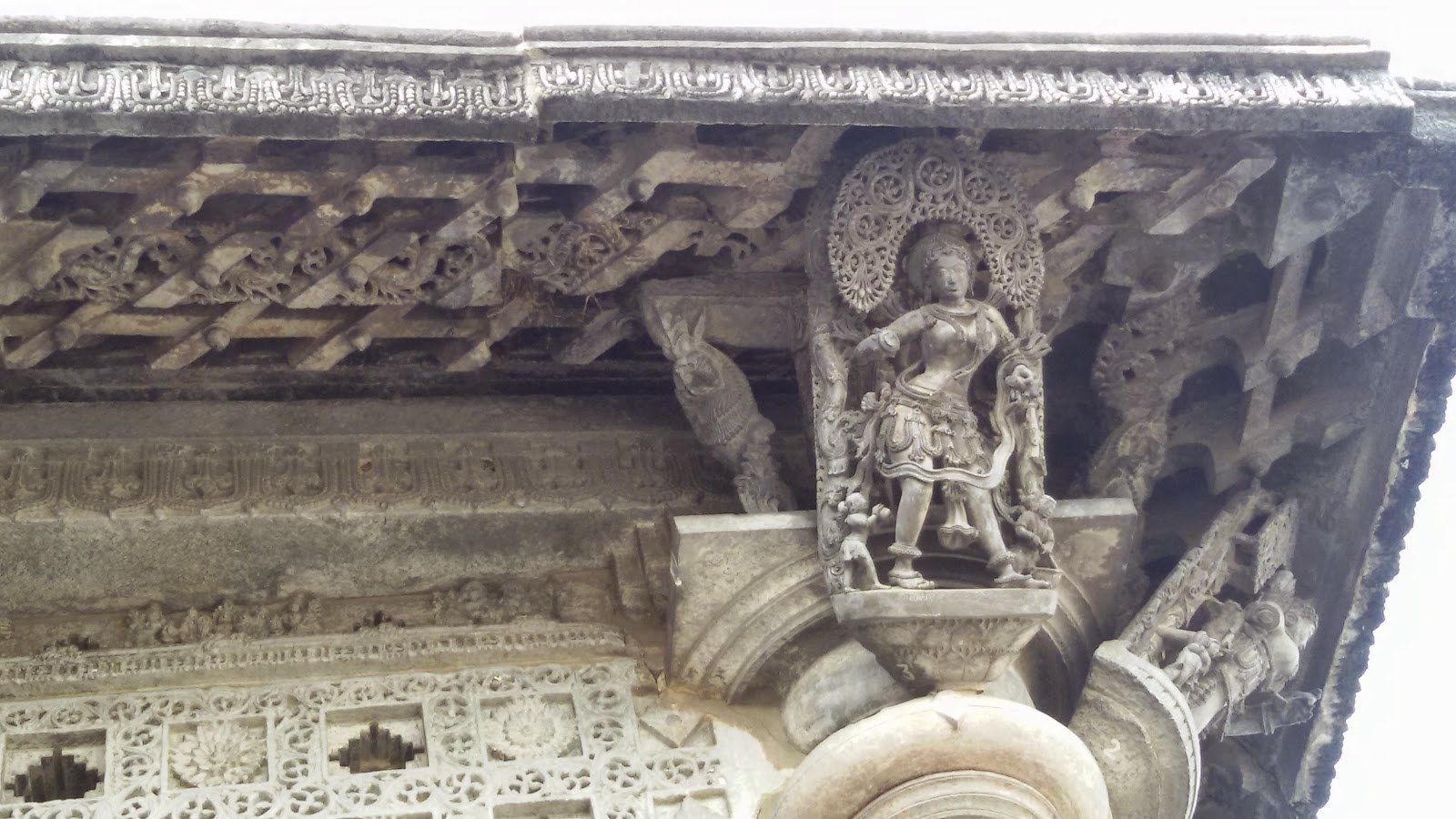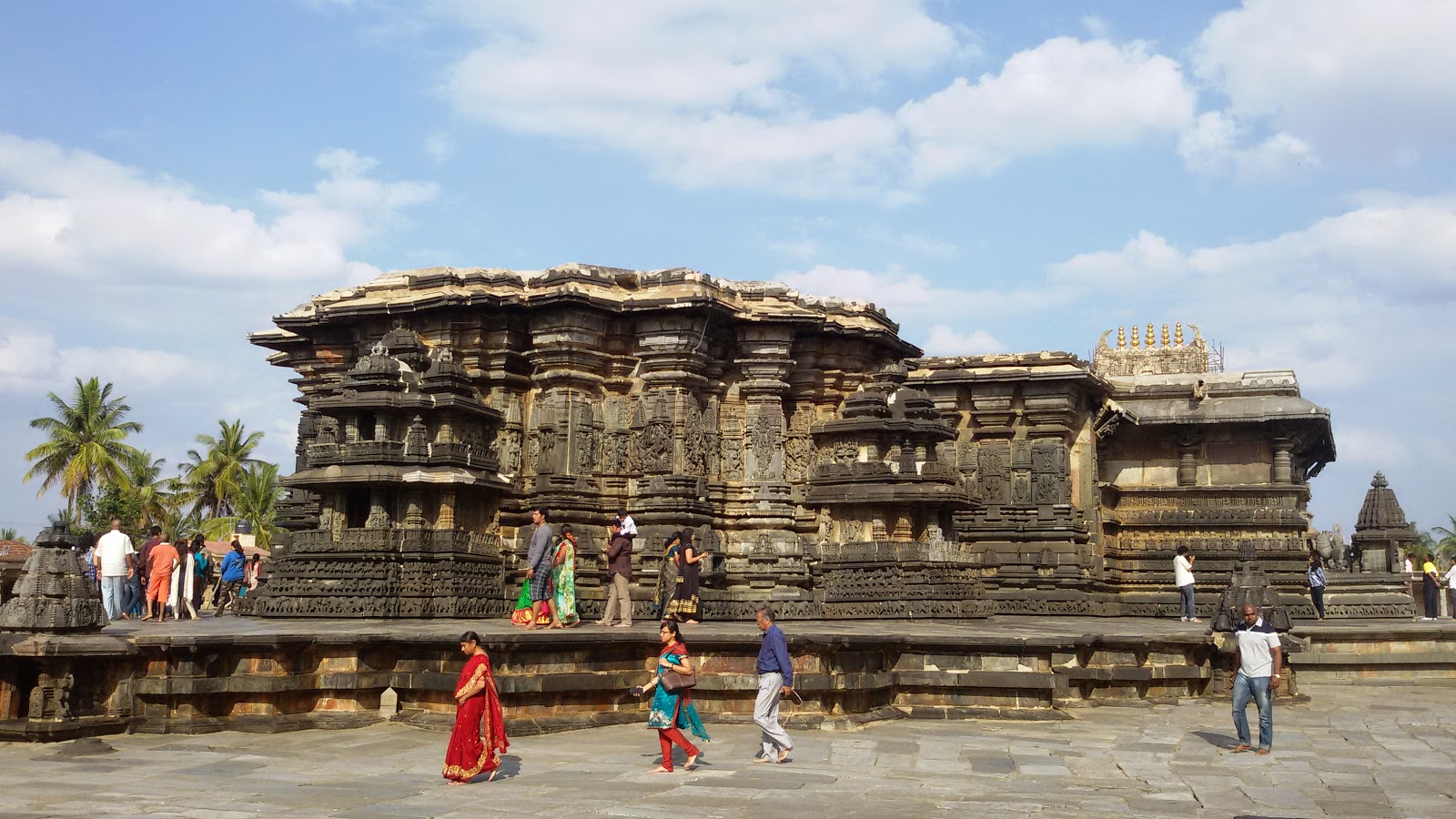Apart from the fact that the name of this place is a mouthful, the main activity here entails climbing the long flight of stairs, with pauses in between, all the while enjoying the lovely breeze even in the middle of a supposedly scorching afternoon (for those trained in
Delhi summers, this is literally a breeze! :D).
So, our trip went from
Belur back towards
Hassan to rest for the night and to recoup our energies for the next exciting morning. :)
 |
| It's a short distance from Hassan to Shravanabelagola, but one always has the option of getting lost! :D |
The next morning was the 26th of January and was as such dominated by the 66th Republic Day Celebrations on T.V. and we couldn't do anything else other than sitting glued to the at-that-moment-not-so-idiot box. Even the foggy skies in
Delhi couldn't bog down our spirits. But this did interfere a little with our plans, as we could only start after the parade was over and that meant past noon... No hay problema! :)
 |
| Loved the theme of the 66th Rebublic Day Parade: "Nari Shakti" (Women Power)! :) |
While driving from
Hassan to
Shravanabelagola we were again struck by the lovely highway and its green bodyguards on both sides! There is something about
Karnataka apart from its fantastic heritage sites that puts it in the same league as
Kerala and
Rajasthan in terms of touristic value - its landscapes.
 |
| Disclaimer: This photo was taken while standing still on the side of the highway and not while driving. The dash-ing median is proof. ;) |
Through these very greens was a turn that we were looking out for - the shortcut to
Shravanabelagola. Our GPS pointed towards one right turn (actually a U-turn and then a left) and we confidently took it. The misgivings arose after 5 minutes. Were we on the right track? What if this village road was not connected to the main road leading to
Shravanabelagola? Would the road condition deteriorate? Would our GPS continue to pick up signals here?
 |
| Shortcut through a village - Praying the whole slightly bumpy while for the GPS to be correct! |
The prospect of getting lost didn't stop us from appreciating our surroundings. How lovely it is to venture through green fields and coconut trees on a small road! And in the end, we did come out on the main road and from there
Shravanabelagola was just a few minutes away.
As we rounded the last bend, we saw a huge smooth surface on our right. In the distance we could see a tiny flight of stairs winding through the
Vindhyagiri Hill. I tried to be cheerful, but my spirits sank as Ma and Pa looked doubtfully at the innocent hill and announced:
We are not climbing up there! My feeble attempt to encourage them: "
We'll take lots of breaks." didn't really seem to work. Nevertheless, we all bought the mandatory sun hats and socks offered to us by young businessmen-in-offing. As we went inside the premises, I tried not to say anything at all. They both are 65+ and know their limits and I didn't want them to do anything they physically didn't feel upto. After all there were 650 odd steps leading up (we didn't know the exact number as we stood at the bottom) and it was peak afternoon. All the while moving towards the place to deposit our shoes and bags I was wondering if I was going to go up alone. And then Pa said: "
We'll take a lot of breaks, let's try." Yayyyy! I was willing to sit down after every 10 steps. :D
 |
| First break :) |
So, up we went, stopping every now and then to admire the beauty of our surroundings, concentrating on the stone steps (that didn't seem to be very hot through our new oversized socks) and sipping water every 10 minutes or so. Shade was in short supply, so we tried to make the most of what was available. I was so happy, I could have gone up and down the stairs all day! :D
 |
| Caution: Last shade for the next 300+ steps! :D |
It was lovely to see how friendly everyone was - families ensuring everyone stayed together, groups of youngsters and habitual climbers taking two steps at a time or not taking the stairs at all and climbing the mountain unaided, couples supporting each other during the seemingly tough climb, old people driven by religious fervour, few foreign tourists attracted by the ancient vista - all of them were happy to share a word or two, as we moved up at a comfortable pace.
 |
| We can do it! :D |
I was counting the stairs as we moved up and they simply seemed to go on and on!! The reward was the view that we had on looking back.
 |
| The 'Belagola' (white pond) behind the name: The view became better as we moved up... talk about bird's eye perspective! |
After about 550 stairs or so there was a flatter surface with ancient carvings and inscriptions. The site goes back about 2000+ years and the inscriptions throw light on the craftsmen as well as the great public figures of those times. For example the
Tyagada Khamba built in the 10th century stands testimony to the minister
Chavundaraya, who gave away all his worldly possessions, including his life, on this hill. This made me think of the
Vivekananda Rock off
Kanyakumari. Strange coincidence that huge rocks and hills in the South of India have for centuries inspired people to look within, away from the material world.
 |
| Tyagada (literally meaning 'renunciation' or 'sacrifice') Khamba |
Not to be overlooked were the various inscriptions and carvings etched in the hard surface by the unknown workers of yore. So, someone sat on this hot rock and hammered in these figures that would, centuries later, fascinate people from all over the world; I'm sure one could hear the rhythmic pounding of the ancient hammer with the right amount of concentration and imagination. :)
 |
| Rock carvings of animals have been in vogue in all centuries. This artist was dreaming of horses - No Freudian significance insinuated! |
Ma and Pa's enthusiasm to try new things was another thing to admire for me. And their smiles on having come so far were enough to make the whole exercise worthwhile. :)
 |
| :) |
As we reached the top, we could view the top of the largest monolithic statue in the world!
Bahubali welcomed us with open arms... err, figuratively speaking. :D
Did you know that devout Jains try to safeguard every living being and practice non-violence and self control to the extreme? Picture this, as a strict Jain follower you would not harm any living being including insects, follow vegetarianism to the extent of avoiding root vegetables such as onion, garlic and potatoes (yes, potatoes!) and be open-minded towards other beliefs and practices! This has to be one of the few religions in the world that is so accommodating!
The majestic statue stands tall at 58 feet and occupies centre-stage. No amount of carvings in the area surrounding it can take away attention from the
Gomateshwara. Jain pilgrims have been flocking here since centuries. Just to give a perspective into the history of Jainism here:
Chandragupta Maurya, the first emperor to unify most of India into an empire, converted to Jainism and led an ascetic life on this very hill, finally leaving the worldly domain in 298 BC. And this awe-inspiring work of art and engineering has been standing on
Vindhyagiri since 978-993 AD! It must be a sight to see, when every 12 years the statue is bathed in milk, curd, saffron, turmeric and gold coins (!) as part of the
Mahamastakabhishek ceremony! To witness the next one, one only needs to wait till 2018.
Coming back to 2015, we were reminded of the upcoming
Delhi elections in February, when the priest asked us politely, where we were from. On hearing '
Delhi', he immediately preached: "Vote for BJP!!!" :D Is religion apolitical? Definitely not in India!
Having had our fill, we decided to go down (also because our stomachs were rumbling their displeasure at being ignored for so long!) and took a last look at the magnificent history sprawled below us.
 |
| You glance down and history glances up through its centuries old veil! |
This concluded our triple agenda of visting Belur, Halebid and Shravanabelagola and we were calm and ready to face Bangalore traffic on our way back. Not that being calm and ready prepares you for the actual thing, but anyway... :D













































